Musée d'Art et d'Histoire du Judaïsme
 The statue of Captain Dreyfus in the courtyard of the Hôtel de Saint-Aignan | |
| Location | 71 rue du Temple 75003 Paris |
|---|---|
| Type | Jewish museum, Art museum, History museum, Historic site |
| Public transit access | |
| Website | www.mahj.org |
The Musée d'Art et d'Histoire du Judaïsme (French for "Museum of Jewish Art and History") is a French museum of Jewish art and history located in the Hôtel de Saint-Aignan at 71 rue du Temple in the Marais district in Paris. The museum is open daily except Saturday (Shabbat). An admission fee is charged. The nearest métro station is Rambuteau.
The museum traces the evolution of the Jewish world via its artistic and cultural heritage, focussing on the history of the Jews in France since the Middle Ages and evoking the communities of Europe and North Africa. Its collection, one of the finest in the world, comprises religious objects, manuscripts, textiles and unique archive documents concerning the Dreyfus Affair. Special importance is given to the Jewish presence in the arts, featuring the painters of the School of Paris (Chagall, Kikoïne, Soutine…) and contemporary artists such as Christian Boltanski and Sophie Calle.
The Permanent Collection

Introductory room
The visit begins with an introductory presentation of symbolic objects and fundamental documents, essential to an initial understanding of the permanence of Jewish civilization in spite of its geographical Diaspora. An audio-visual presentation of faces, famous and anonymous, from history, art and literature, portrays the diversity of the Jewish culture through time and space.
The Jews in France in the Middle Ages
Gravestones from a 13th century Jewish cemetery in Paris, set in a large wooden plot, comprises the room's central exhibit. At the far end, a glass-topped presentation counter contains valuable manuscripts. Four rare objects, a Hanukkah lamp, a wedding ring, an alms box and a seal, dating from before the Jews' expulsion from France, illustrate the painful contrast between the cultural wealth of medieval Judaism in Northern France and Provence, and its violent extinction following Philippe le Bel's edict expelling the Jews from France in 1306 and then Charles VI's edict banishing them completely in 1394. The visitor is given an initial picture of community organisation, knowledge networks and the Jewish presence in the Christian world.
The Jews in the Italian Renaissance
After a transitional space establishing the expulsion of the Jews from Spain in 1492 as one of the seismic events in Jewish history, comes the space devoted to synagogue furniture (including a Holy Ark from Modena), silverware and liturgical embroideries and the Italian Jewish world. Life's cycle - birth, circumcision, bar mitzvah (religious confirmation) and marriage - is illustrated by objects, jewellery and manuscripts. Illuminated marriage contracts (ketubbot) are displayed in mobile frames. Several paintings from the 18th century, attributed to Marco Marcuola, illustrates scenes (a wedding, a circumcision, a funeral…) from the Jewish life in Venice. A 1720 masterpiece by Alessandro "il Lissandrino" Magnasco depicts a Jewish funeral in Magnasco's dark, late-Baroque style.
_Venise%2C_vers_1780.jpg) Jewish Wedding, Marco Marcuola, Venice, around 1780
Jewish Wedding, Marco Marcuola, Venice, around 1780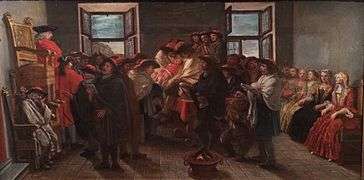 A circumcision, Marco Marcuola, Venice, around 1780
A circumcision, Marco Marcuola, Venice, around 1780 Jewish Funerals, Alessandro Magnasco, Genoa, around 1720
Jewish Funerals, Alessandro Magnasco, Genoa, around 1720
Hanukkah
An entire room of the museum is dedicated to the Hanukkah holyday, through an exceptional collection of Hanukkiyot (Hanukkah lamps), in a variety of shapes and designs, origins and periods. This panorama stands as a metaphor for the great diversity of Jewish customs throughout the world.
%2C_France_-_Mus%C3%A9e_d'art_et_d'histoire_du_Juda%C3%AFsme.jpg) France, 14th century
France, 14th century_-_Mus%C3%A9e_d'Art_et_d'Histoire_du_Juda%C3%AFsme.jpg) France, 16th century
France, 16th century Germany, 17th century
Germany, 17th century Italy, 18th century
Italy, 18th century_-_Mus%C3%A9e_d'Art_et_d'Histoire_du_Juda%C3%AFsme.jpg) Poland, 18th century
Poland, 18th century%2C_end_of_the_19th_century_-_Mus%C3%A9e_d'Art_et_d'Histoire_du_Juda%C3%AFsme.jpg) France, 19th century
France, 19th century Europe, 19th century
Europe, 19th century Yemen, 20th century
Yemen, 20th century Tunisia, 20th century
Tunisia, 20th century Israel, 20th century
Israel, 20th century
Amsterdam: the meeting of two Diasporas
The wanderings of the Spanish Jews are pursued in a small collection of 17th and 18th century Dutch engravings. It includes a series by Bernard Picard entitled Ceremonies and Religious Customs of all Peoples of the World and provides an introduction to the model integration of the Portuguese Jews in Amsterdam, London and Bordeaux. The accent in this space is on the importance of relations between communities. At the meeting point of these last two spaces, display cases are devoted to the development of Hebrew printing.
Next year in Jerusalem
One of the museum’s essential pieces is a 19th century Sukkah from Austria or South Germany, decorated with a view of Jerusalem’s old city. Along with other ritual objects and texts, it introduces the Three Pilgrimage Festivals, Pesach, Shavuot and Sukkot, and highlights the central place of Jerusalem in the mind of the Jewish Diaspora scattered in the world.
The Ashkenazi world
_-_Mus%C3%A9e_d'art_et_d'histoire_du_Juda%C3%AFsme.jpg)
Several scale models of synagogues from Poland, Ukraine and Lithuania, most of them destroyed by the nazis, reminds the existence of a world now disappeared. Samuel Hirszenberg's masterpiece Jewish Cemetery illustrates the critical situation of the Jewish communities harmed by the pogroms in Poland and Russia, at the end of the 19th century. Two paintings by Marc Chagall, born in a Hasidic family near the city of Vitebsk (Belarus, then part of the Russian Empire), portrays the life in the shtetls. This collection marks the beginning of an exploration of the traditional framework of Jewish life in Eastern Europe through its key emotional moments and settings. The display cases contain works on the theme of the Shabbat, prayer and liturgy, and provide a brief picture of the organisation of religious study and the principal movements of religious thought in 19th century.
The Sefardi world

The Sephardic expression of the same themes is shown. These two symmetrical collections enable an appreciation of the formal kinship between the two traditions and the weight of influences. Textiles, among them a wedding dress (berberisca), synagogue silverware including a Torah case (tik), ordinary domestic objects, printed works and popular art, presented in large mural display cases, highlight geographic contrasts in religious custom.
This space contains a wide range of ethnographic objects illustrating the wealth of traditions, family ceremonies and the opulent costumes of the Jews of the Maghreb, the Ottoman Empire and the Middle East. Orientalist paintings, engravings and ancient photographs complete this journey among the communities of the Diaspora.
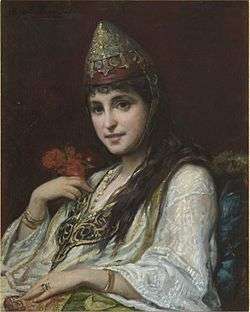
Jewish Emancipation: the French Model
We now enter the era of the Emancipation, which began with the French Revolution. No longer thematic but more historical in nature, this panorama of French Judaism in the 19th century focuses on vital events in its integration into modern society. This theme is pursued in works depicting Jewish themes (Moritz Oppenheim) and genre paintings by French and European artists (France: Alphonse Levy, Edouard Brandon, Edouard Moyse ; Poland: Samuel Hirszenberg, Mauricy Gottlieb and Mauricy Minkovski). These works enable an initial reflection on the possibility of a Jewish art other than merely liturgical or traditional ones.
This section includes material from the Fonds Dreyfus, an exceptional archives fund donated by the grandchildren of Captain Dreyfus, which comprise more than three thousand manuscripts, letters, photographs, family heirlooms, official documents, books, postcards, posters, etc.[1]
 Law proclaiming the Emancipation of the Jews (1791)
Law proclaiming the Emancipation of the Jews (1791)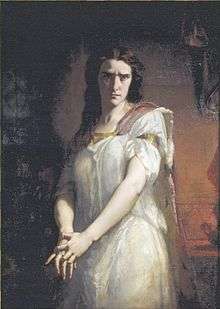 Rachel dans Lady Macbeth, Charles-Louis Müller (1849)
Rachel dans Lady Macbeth, Charles-Louis Müller (1849)_-_Mus%C3%A9e_d'art_et_d'histoire_du_Juda%C3%AFsme.jpg) Presenting the Torah, Edouard Moyse (1860)
Presenting the Torah, Edouard Moyse (1860)_-_Mus%C3%A9e_d'art_et_d'histoire_du_Juda%C3%AFsme.jpg) Evening prayer, Alphonse Levy (1883)
Evening prayer, Alphonse Levy (1883)
Intellectual and political movements in Europe
This section shows the European Jews' flourishing intellectual life at the turn of the century, including the emergence and spread of the Zionist idea, the rebirth of the Hebrew language, the blooming of Yiddish culture and the creation of political movements in Russia and Poland, in particular the Bund.
The Jewish presence in 20th century art
A graphic arts room, highlighting the Jewish cultural renaissance in Germany and Russia, contains works on paper and books from the beginning of the 20th century. The museum fulfils one of its missions here, that of deepening our knowledge of the major formal and stylistic directions taken by important and sometimes forgotten artists. With the focus on folklore, ornament, Biblical subjects and calligraphy, these works represent the accomplishment of artistic expression linking Jewish themes and identity.
This look at the contribution of Jewish artists to the art of the early 20th century ends with works by artists of the School of Paris: Amedeo Modigliani, Pascin, Chaim Soutine, Michel Kikoine, Jacques Lipchitz, Louis Marcoussis, Chana Orloff, Moïse Kisling, etc. By the diversity of their individual artistic development and above all through their confrontation with modernity, these artists exemplify the transition towards a new, no longer exclusively religious Jewish identity.
_Mus%C3%A9e_d'art_et_d'histoire_du_Juda%C3%AFsme.jpg) The Cemetery Gates, Marc Chagall (1917)
The Cemetery Gates, Marc Chagall (1917)_-_Mus%C3%A9e_d'art_et_d'histoire_du_Juda%C3%AFsme.jpg) Paysage de Céret, Chaim Soutine (1919)
Paysage de Céret, Chaim Soutine (1919)_-_Mus%C3%A9e_d'art_et_d'histoire_du_Juda%C3%AFsme.jpg) The Jewish Painter, Chana Orloff (1920)
The Jewish Painter, Chana Orloff (1920)_-_Mus%C3%A9e_d'art_et_d'histoire_du_Juda%C3%AFsme.jpg) Eglise de Gentilly, Michel Kikoine (1928)
Eglise de Gentilly, Michel Kikoine (1928) Jeune femme en buste, Amedeo Modigliani
Jeune femme en buste, Amedeo Modigliani
To be a Jew in Paris in 1939
While wishing to avoid creating a collection devoted to the Holocaust, the museum felt it important to retrace the emblematic lives of a few Eastern European, Russian, Polish and Romanian Jews who came to live in Paris at the beginning of the 20th century and whose individual paths all led to the Hôtel de Saint-Aignan. Using archive sources, the museum creates a documentary picture of the history of European Judaism, the end of the exterminated communities, immigration in Paris, Jewish life in the Marais quarter and crafts and community associations.
In conjunction with this presentation, Christian Boltanski has created a work for a tiny courtyard inside the museum. This installation, consisting of the names of Jews who, before being deported, lived in this mansion when it was merely a collection of workshops, reveals the building's other history, a history of humble people which the restoration has erased. The work fills the spatial vacuum of this courtyard, which rises through the museum's 20th century spaces.
%2C_Christian_Boltanski_-_Mus%C3%A9e_d'art_et_d'histoire_du_Juda%C3%AFsme_-_Boltanski.jpg)
The Dreyfus affair
In 2006, together with the exhibit Alfred Dreyfus, the Fight for Justice, the museum created an online platform dedicated to the Dreyfus affair, giving access to more than 3 000 documents, letters, photographs and historical archives donated by the grandchildren of Captain Dreyfus.[2]
The finest pieces of this exceptional archives fund are displayed in a dedicated space, as part of the permanent collection. Among them figures Captain Dreyfus's ripped off officer stripes, picked up on the day of his public degradation by police commissioner Charles Péchard and later given to the Dreyfus family.
At the center of the museum courtyard stands an 8 feet high statue of Alfred Dreyfus, holding to his honor and to his broken sword, made by French artist Louis "TIM" Mitelberg in 1986.
 Alfred Dreyfus in 1890
Alfred Dreyfus in 1890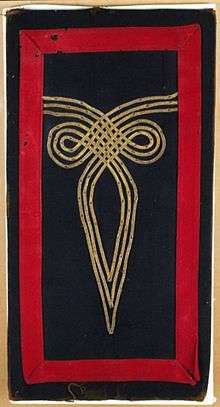 Captain Dreyfus's ripped off officer stripes
Captain Dreyfus's ripped off officer stripes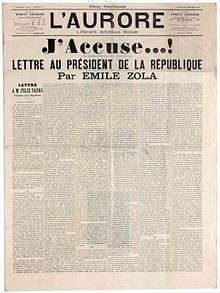 J'accuse...!, 1898 letter by writer Emile Zola accusing the government for his treatment of the Dreyfus affair
J'accuse...!, 1898 letter by writer Emile Zola accusing the government for his treatment of the Dreyfus affair Poster of the 2006 exhibit Alfred Dreyfus, the Fight for Justice
Poster of the 2006 exhibit Alfred Dreyfus, the Fight for Justice
History
The Hôtel de Saint-Aignan

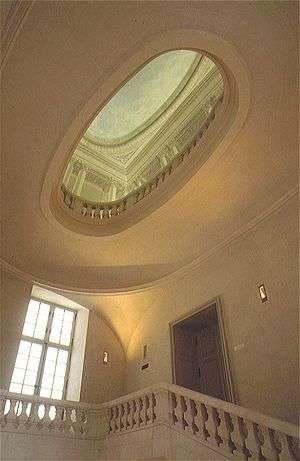
The mansion was built from 1644 to 1650 for Claude de Mesmes, Count of Avaux, who aided Cardinal Richelieu and Cardinal Mazarin in the negotiation of the treaties of Westphalia (1648). It was designed by the architect Pierre Le Muet (1591–1669), known for his treatise entitled Manière de bâtir pour toutes sortes de personnes (‘How to Build for All Kinds of People’) (1623) and the quality of his châteaux (Chavigny, Pont and Tanlay 1638–45).
The mansion was built on a large, irregularly-shaped plot formerly occupied by the townhouse Claude d’Avaux inherited in 1642. Le Muet demolished the old building and adopted the usual ground plan for large aristocratic mansions, with the residence itself set back from the street, at the rear of a large, slightly rectangular courtyard so that one has the impression it is square on entering. The single wing on the right housed the kitchen, servants’ room and dining room on the ground floor, and a large gallery above (like the Hôtel de Sully at the outset). An archway led through to a second, smaller courtyard, where the outhouses and stables had their own street entrance. To create a symmetrical effect, Le Muet decorated the blank wall of the adjoining property on the left (corresponding to the Philippe Auguste’s city wall) with pilasters and false windows imitating the right wing.
Paul de Beauvilliers, Duke of Saint-Aignan, who bought the mansion in 1688, divided the gallery into separate rooms, which were reached from the second courtyard by a partially suspended staircase. He used a small adjoining plot, acquired from a neighbour, to enlarge the right wing with rooms on the garden side. He had the garden redesigned by André Le Nôtre, who installed flowerbeds, a pond and latticework.
After its confiscation in 1792, the mansion became the seat of the Seventh Municipality in 1795, then of the Seventh Arrondissement until 1823. It was subsequently divided up into commercial premises of all kinds, which were heightened and extended by their occupants. After the mansion’s acquisition by the City of Paris and its classification as a historic monument (1963), restoration work was carried out over the next twenty-five years with lengthy interruptions. Discounting the additions made in 1690 and several errors (skylights on the courtyard side, first-floor ceiling lower than the window arches), the restoration and partial rebuilding (roofs, staircase), completed in 1998, restored the mansion to its original state. It is one of the finest Parisian examples of the serenely classical style known as Atticism built during Anne of Austria’s regency.
The Italian architect Vincenzo Scamozzi, travelling in France in the early 17th century, was surprised that one entered even the great mansions via a staircase. Around 1640, however, entry halls, until then rare, became increasingly frequent, and at the Hôtel de Sully, like the Château de Maisons, an entrance hall in the antique style, with niches and pilasters, was created in front of the staircase.
Although the hall survived the 19th-century alterations intact, the staircase was demolished completely. The only traces were the hollows left in the walls by the steps and landing vaults, and fragments of the balustrades and string-board. These elements and Le Muet’s original plans were enough to reconstruct it.
Le Muet’s design was a variation on the new type of staircase invented by François Mansart: spectacular but unfinished at Blois, more modest but complete at Maisons. The staircase proper leads up to the first floor. The second floor is reached via a small lateral flight of steps. An upper landing rings the stairwell, creating an oval opening onto the calotte above.
The trompe-l’oeil view of the calotte is a modern creation inspired by a sketch (in fact only of the quadratura and not of the scene above) originally proposed for the Hôtel d’Avaux, but explicitly annotated ‘not done’. It therefore probably does not comply with Claude d’Avaux’s decision and Le Muet’s final choice to leave the calotte blank – Le Muet was the foremost Parisian exponent of Atticism.
In 1842, the mansion, having changed hands several times, is divided up into workshops. Transformed into a commercial premises, the building’s only living quarters are on the third floor. Contemporary photographs, in particular those by Eugène Atget, show life in the Hôtel de Saint-Aignan, now lived in by Jewish immigrants from Poland, Romania and the Ukraine.
In 1942, during the main roundups of the Jews in Paris, several inhabitants of the building were arrested and deported. Thirteen of them died in Nazi concentration camps.
The Hôtel de Saint-Aignan is acquired by the City of Paris in 1962.
The restoration programme begins in 1978, directed by Jean-Pierre Jouve, Architect in Chief of the National Office of Historic Monuments and Sites. At this point, the mansion is destined for use by the National Archives of Paris.
In 1986, on the initiative of the Mayor of Paris, Jacques Chirac, the Hôtel de Saint-Aignan is made available to a museum of Jewish civilisation, the Musée d’art et d’histoire du Judaïsme.
A second restoration was carried out in 1991 by Bernard Fonquernie, Architecte en Chef des Monuments Historiques. The museum's mise-en-scène was designed by Catherine Bizouard and François Pin.[3]
The museum opened in 1998, and the initial collection was formed by combining the Strauss-Rothschild gift built up by Isaac Strauss and given by Baroness Nathaniel de Rothschild in 1890 to the Musée de Cluny, with the holdings assembled since 1948 by the Musée d'Art Juif. This collection has been enhanced by acquisitions and donations of art, and historical and ethnological objects.
The museum reflects the history of Jewish communities in France, Europe, and North Africa, from the Middle Ages to the present. It contains archives of the Dreyfus affair, 20th-century art (Chagall, Modigliani, Soutine, Michel Kikoine), as well as objets d'art, textiles and manuscripts, and a 182-seat auditorium. The Carnavalet Museum has added to its collection of medieval tombstones.
See also
References
Notes
- ↑ http://dreyfus.mahj.org/docs/index.php
- ↑ http://dreyfus.mahj.org/docs/index.php
- ↑ Ayers 2006, pp. 71–72.
Sources
- Ayers, Andrew (2004). The Architecture of Paris. Stuttgart; London: Edition Axel Menges. ISBN 978-3-930698-96-7.
- Musée d'Art et d'Histoire du Judaïsme
- Ivy Paris description
- Stephen Fallon, Paris, Lonely Planet, 2004, page 89. ISBN 1-74059-760-5.
- Address by President of Republic Mr. Jacques Chirac on the Occasion of the Inauguration of the Musée d'Art et d'Histoire du Judaïsme, Paris, November 30, 1998
External links
| Wikimedia Commons has media related to Musée d'art et d'histoire du judaïsme. |
Coordinates: 48°51′40″N 2°21′19″E / 48.86111°N 2.35528°E